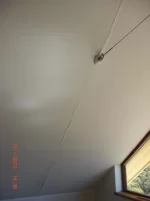Curmudgeon
New Member
Hi All,
I'm in Western Australia; There was a pine timber ceiling with exposed rafters every 1200 (4ft) with corrugated tin roof over that. There were small timber collar ties at the height of the stainless tension wires I've replaced them with and the pine ceiling was fixed to the 50mm collar ties. I wanted to increase insulation and to expose the raking ceiling to the ridge. So I've bolted the brackets for the Stainless steel tensile wires at the same height as the old collar ties and tensioned up the turnbuckles. I filled the 150mm between the rafters with wool insulation and then used liquid nails and 40mm screws to fix 18mm mdf sheets horizontally across the rafters. Then I've used plenty of liquid nails on the face of the MDF sheets and plasterboard screws to fix 12mm sheets of gyprock straight onto the MDF. I've then used wet and stick paper tape on the joints and built up the joints with jointing compound.

This is what I get..... horrendous!!
Actually, this is what I get 3rd or fourth time round.... I've tried to grind it all back and redo it over and over with exactly the same result each time.
This doesn't happen immediately... it seems to happen when we get into summer (it gets to 40c here 110f fairly regularly). But I've run out of ideas as to how to resolve this? I'm going to end up putting a timber bead over it. But I want to know what I've done wrong and how to avoid it again in the future. Or even if I can salvage this now?
Help... otherwise I'll be slinging a rope over one of those SS wires!
Thanks all.
I'm in Western Australia; There was a pine timber ceiling with exposed rafters every 1200 (4ft) with corrugated tin roof over that. There were small timber collar ties at the height of the stainless tension wires I've replaced them with and the pine ceiling was fixed to the 50mm collar ties. I wanted to increase insulation and to expose the raking ceiling to the ridge. So I've bolted the brackets for the Stainless steel tensile wires at the same height as the old collar ties and tensioned up the turnbuckles. I filled the 150mm between the rafters with wool insulation and then used liquid nails and 40mm screws to fix 18mm mdf sheets horizontally across the rafters. Then I've used plenty of liquid nails on the face of the MDF sheets and plasterboard screws to fix 12mm sheets of gyprock straight onto the MDF. I've then used wet and stick paper tape on the joints and built up the joints with jointing compound.

This is what I get..... horrendous!!
Actually, this is what I get 3rd or fourth time round.... I've tried to grind it all back and redo it over and over with exactly the same result each time.
This doesn't happen immediately... it seems to happen when we get into summer (it gets to 40c here 110f fairly regularly). But I've run out of ideas as to how to resolve this? I'm going to end up putting a timber bead over it. But I want to know what I've done wrong and how to avoid it again in the future. Or even if I can salvage this now?
Help... otherwise I'll be slinging a rope over one of those SS wires!
Thanks all.
